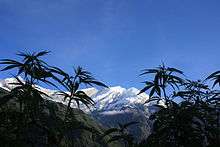Cannabis in Nepal

Cannabis in Nepal has been illegal since 1973, but the region has a long history of use of cannabis as an intoxicant, and continues to produce cannabis illicitly.
History
Nepal has used psychoactive cannabis for centuries, and as early as the 1700s Nepalese charas was recognized as the best available.[1]
In the early 1800s, commentator Francis Buchanan-Hamilton noted:
In Nepal, the Gangja, Charas, or Cannabis sativa, as I have already mentioned, is a common weed : but in that country it is not cultivated, although much used for the purposes of intoxication.[2]
The Hippie Trail
In the 1960s, the Hippie Trail began to route young Western adventurers through Nepal. The stable traditional cannabis economy was rocked by the influx of demand, and the heavy usage by visitors normalized and made trendy cannabis consumption locally. The increased demand and linkage to outside markets led to an increase in hashish production, and smuggling routes established through India and out to the wider world.[3]
Prohibition
In 1973, Nepal canceled the licenses of all cannabis shops, dealers, and farmers, under pressure from the United States and the international community. However, personal cultivation and use were unaffected, and cannabis commerce continued illicitly. The loss of $100,000 in government revenues caused disruption, and later in the 1970s attempts were made at crop substitution.[1]
References
- 1 2 Martin Booth (30 September 2011). Cannabis: A History. Transworld. pp. 325–. ISBN 978-1-4090-8489-1.
- ↑ Francis Hamilton (1819). An Account of the Kingdom of Nepal: And of the Territories Annexed to this Dominion by the House of Gorkha. A. Constable. pp. 231–.
- ↑ Vera Rubin (1 January 1975). Cannabis and Culture. Walter de Gruyter. pp. 255–. ISBN 978-3-11-081206-0.
